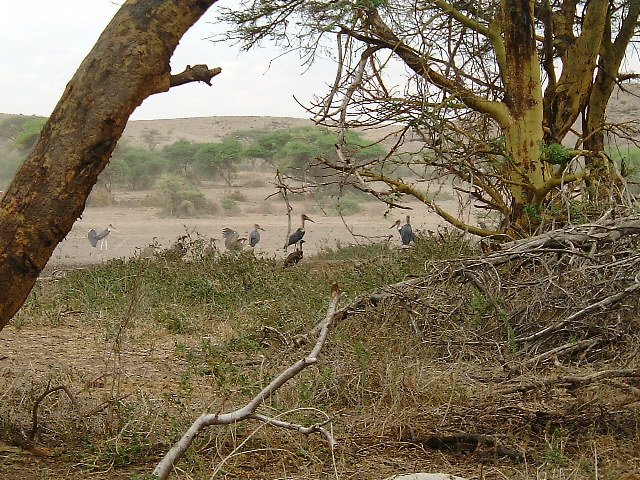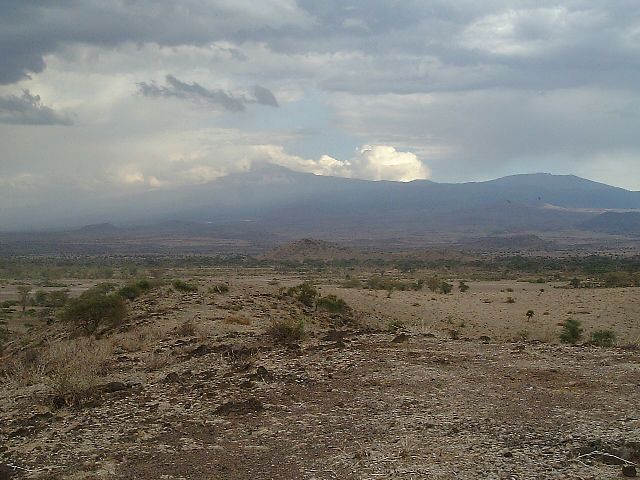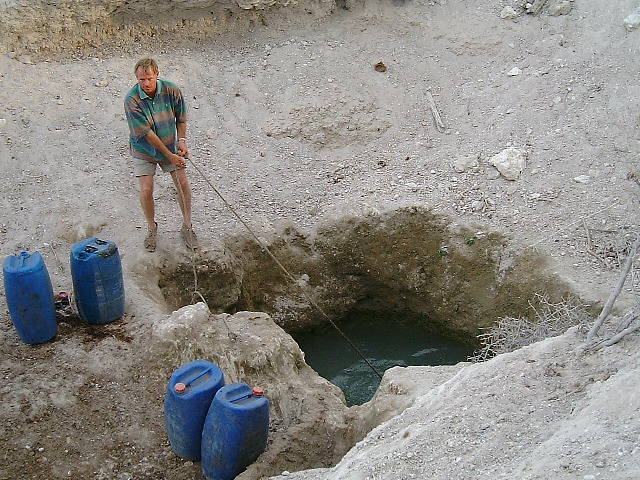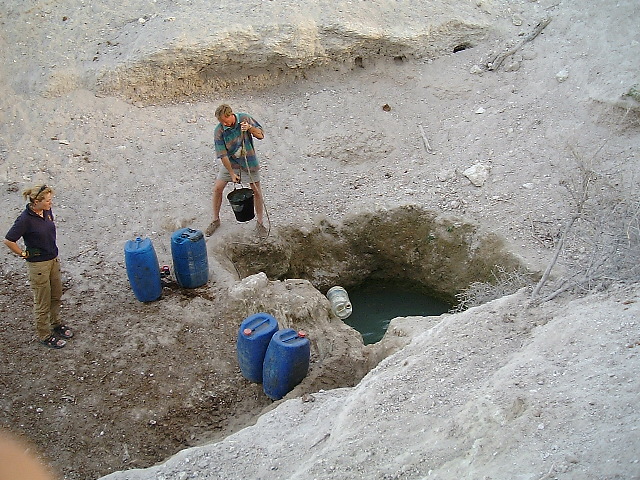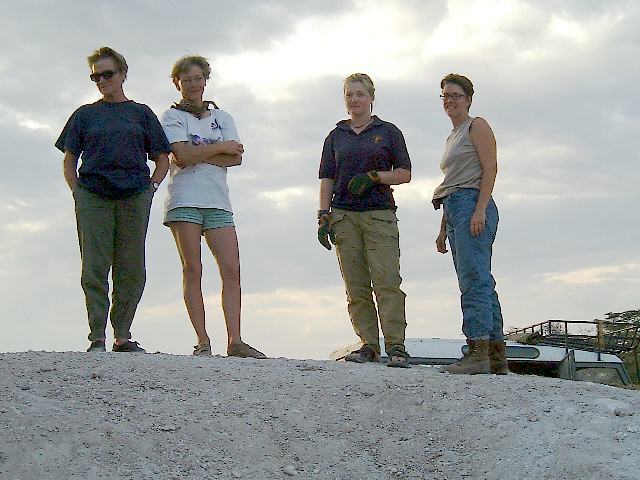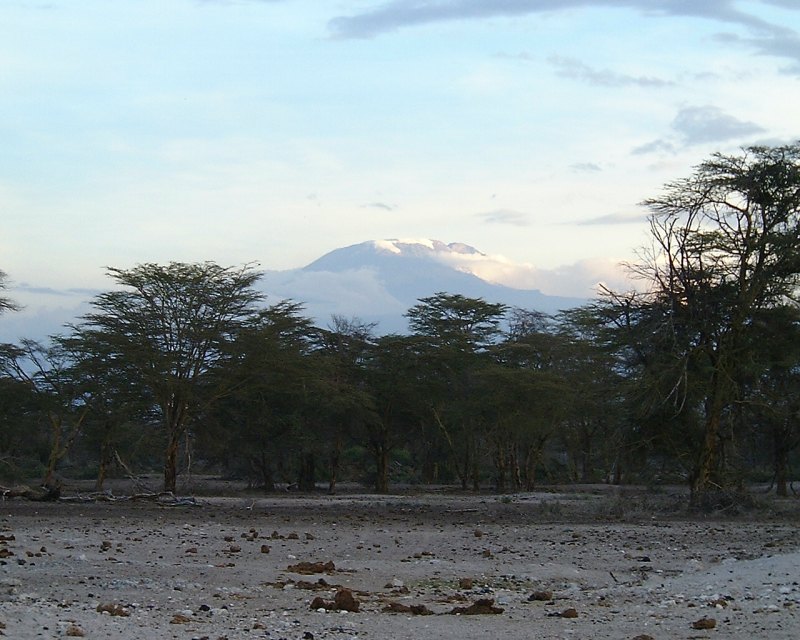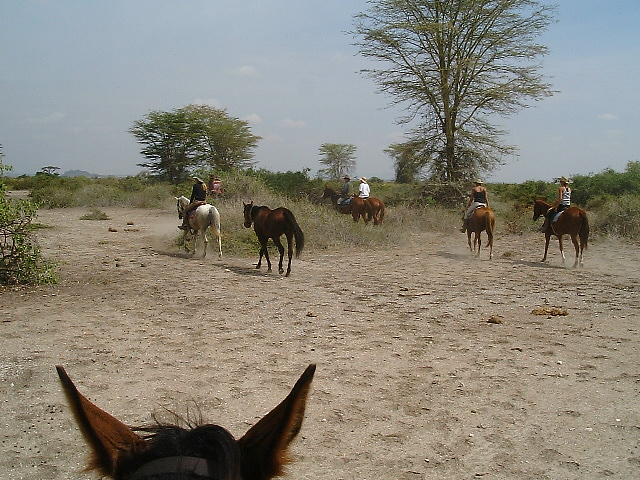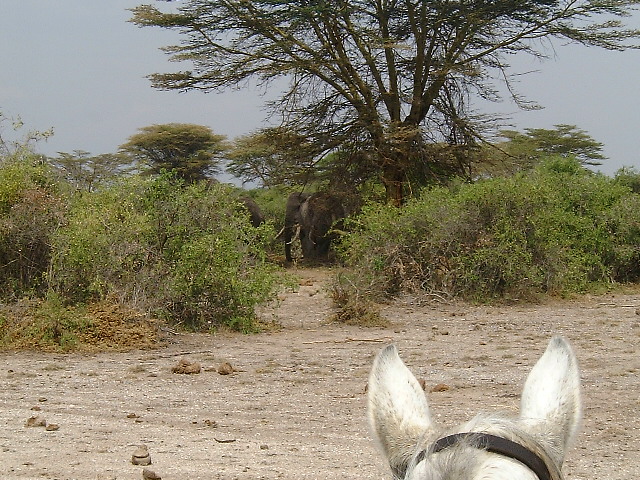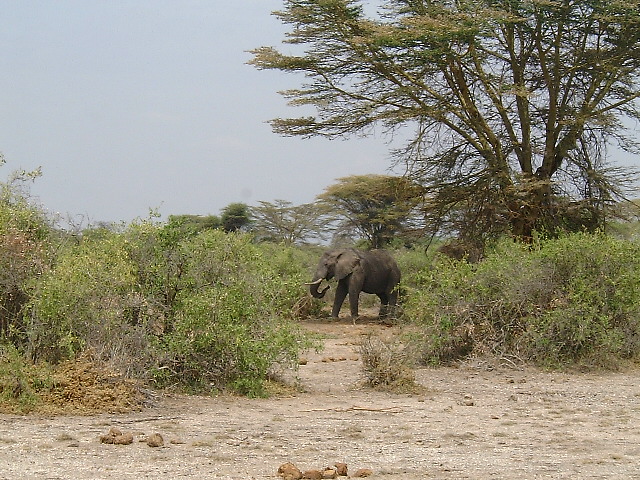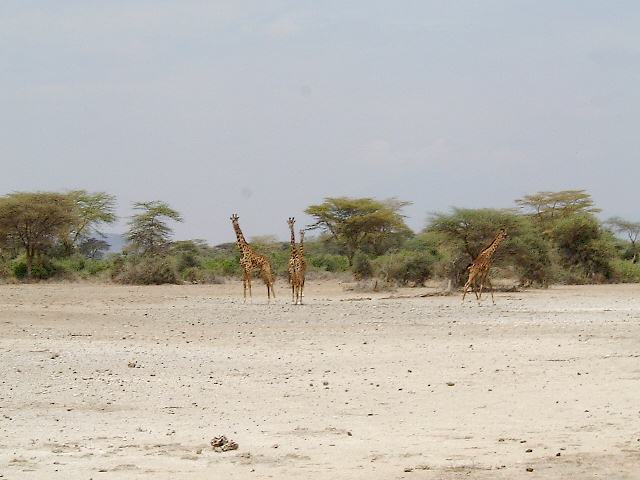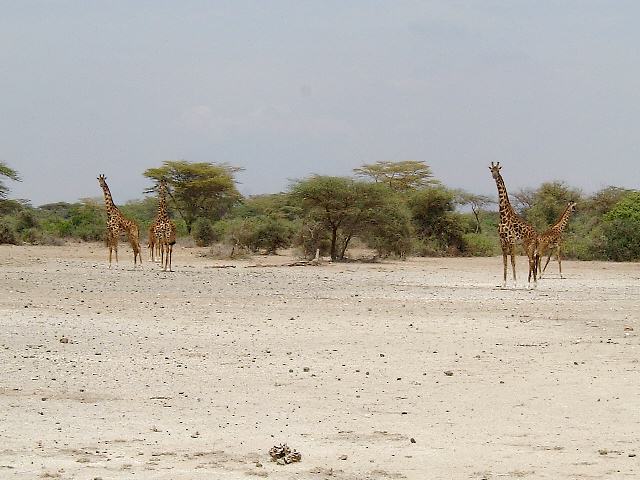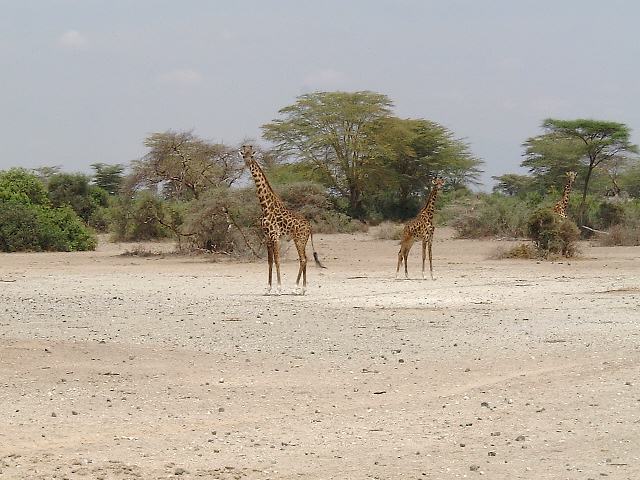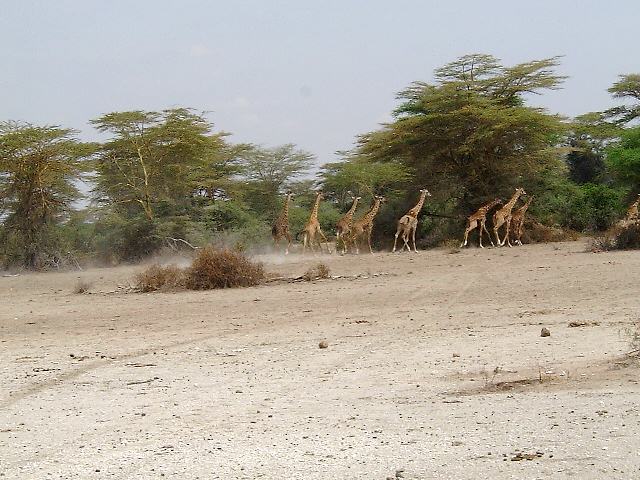Part 1, the Horse Safari By John L. Fuhring PAGE 6 For a guy my age, size and weight I'm a pretty good hiker and can walk at a pretty brisk pace. Way behind me I saw that Masai guy following me, but I stubbornly maintained my lead as we walked across this dry plain and headed for a grove of trees. Up ahead I could see all these vultures and large scavenger birds up in the branches and I really wanted to get close enough to get some digital photographs. As I approached the trees I could hear the Masai guy calling out something, but I didn't understand so I didn't pay any attention. I walked into this clearing and sure enough, there were all these large birds, but so were all these dead animals. The concentration of unbutchered carcasses and the fact that they were all domestic (non wild) animals automatically triggered my "Oh Shit" response. I had this very uneasy feeling.
Thanks to Dave's book, I was sure I was now surrounded by deadly disease and I was also thinking of another charming feature of Masai life. The Masai, in fact, do not bury those of them who are too weak to survive (unless they are very important persons). With some dread I proceed through this charnel grove hoping I wouldn't run into any corpses (I didn't see any, thank goodness). I was thinking: "you fool, why didn't you try to understand what that guy was warning you about." Looking back, I'm pretty sure he was also trying to warn me about approaching this huge boma up ahead from the wrong side and without permission. While I was still in "The Grove of Death" my Masai guy caught up with me and was trying to tell me something. His English was terrible and my Masai was worse than terrible and I just didn't get it (everyone knows that I can be real dense at times - OK most always). I continued on and blundered too near the boma. About eight armed warriors came out followed by an older guy who I guessed was the head man. They didn't look any too pleased by my presence, but made no immediate moves to spear me so I just stood there while the other Masai warrior came up. These guys were duded up really fine in bright red robes and jewelry of gold and bead work. They were armed with shiny Masai spears of the finest workmanship. I couldn't help but admire their appearance and I decided that a dignified interest in them and what they were saying to my Masai guide was the best way to handle the situation. Although very, very tempting, a headlong run back to the camp just wouldn't do under the circumstances (bad show and all that old chap - oh, quite!). Actually it turned out to be quite fascinating watching the Masai warriors talking back and forth. It was very interesting seeing my guy talking the others out of doing something nasty to me (I guess that's what they were talking about). This talk went on and on for the longest time, but it did give me a chance to look over everybody and especially the head guy. In addition to his Warrior's outfit, I noticed that he had slits cut out of his ears and beadwork tastefully woven in. Have no idea how old the guy actually was, but probably younger than me - people don't live very long out there. Finally all the words that needed said were spoken and by now smiles were breaking out all around. The younger warriors stepped forth to shake hands. I didn't know it at the time, but a simple touching of hands is considered polite, but to actually grab and squeeze (American style) is considered uncouth and an act of hostility. Guess how I shook hands with those guys - and they had spears too. Well, that faux pas out of the way, with a big grin on my face, my guide led the way past the boma and toward the slopes of the Kopje. It was a hard climb, and my guide could see it was a little rough on the fat little guy so he slowed down and kept saying "poli, poli" which I knew was Swahili for "slowly, slowly" or "just take it easy." We made it to the top and the view of the surrounding plains and all the animals in the distance was worth the climb. I took my camera and binoculars up there and sharing the binoculars, enjoyed the view.
The climb down was much easier and this time I avoided being pig-headed and followed the advice of my guide. The guy turned out to be a nice fellow and I was sorry we had such a hard time communicating because I felt I could have learned the most wonderful things from him. We skirted the boma by going way to the south (like I should have in the first place). The trail there was much better too. When we got back to camp I thanked my guide most sincerely and then we each reentered our separate worlds. In the late afternoon, it was announced that there would be an expedition to the area of the meerschaum diggings to gather water for our stock. All abled bodied persons and observers were welcome to ride along. This sounded kind of fun and a chance to be useful. We piled in to the Land Rover and started to make our way across country. On the way we surprised a cheetah and got a good look at it as it ran away. I asked Jan about the water we were going after and he said that there were certain open wells where the mineral content of the water was low enough to be suitable for the horses (people can drink it too, but it takes lots and lots of getting use to). I believe that the water is heavily laden with the mineral gypsum which will indeed cause severe diarrhea in humans, but is actually good for horses because it helps prevent the formation of entroliths and impaction colics (so I've read). As can be seen in the photograph, there are several circular wells in the region and lots of evidence of the Masai digging troughs for the cattle to water them. Jan told me a story of how he pulled a baby elephant out of one of the wells on the last trip. If he hadn't come at that moment, the little (little?) creature would have died. I asked about the momma elephant, but apparently she had given up hope for her baby and had rejoined her heard. I assumed the baby found its herd nearby after the rescue. Can't remember how Jan got the rope around the elephant and was able to pull it out - think he used the Land Rover.
To draw the from the well, the hydraulic pumping technology consisted of a steel bucket on the end of a long rope. We unloaded large plastic carboys (holding what I guess was about 15 gallons - 50 liters) as close to the well as possible. Jan proceeded to throw the bucket in the well, draw it out and fill each carboy in turn. I lined up the carboys and dragged them out of the way as they were filled - they sure were heavy. About half way through the filling operation, disaster struck. The knot on the bucket's bail came undone and the bucket filled with water before our eyes and sank to the bottom of the well. It was getting late and I knew we wouldn't have time to get back to the camp and have enough light to complete the task of fetching water. Jan and I talked it over. He said that the water wasn't very deep - less than five feet. I told him that I'd hold the rope and lower him down and once in the well he could grab the bail of the bucket with his toes which is exactly what he did. Jan tied the bucket to the rope and I hauled it up, untied the bucket and threw the rope down so he could tie it to himself and get hauled back up. Pretty soon we were back filling carboys with well water. After the last carboy was filled, the Land Rover was carefully and with some difficulty backed down to as close to the carboys as possible. Loading those carboys was no picnic because they were so blasted heavy. Finally we got them all loaded and were on our way back to camp. What's this?!? Oh no, not another digression - yes, another digression, this time it's about Land Rovers. Those Land Rovers they use in Africa are very unlike the Land Rovers they sell here in the USA. They are true utility vehicles that can perform a whole spectrum of tasks. They are large vehicles, quite Spartan and very rugged with an aluminum body that never rusts and an efficient diesel engine that keeps going and going and going. To top everything off, they have a great suspension that enables them to ride over rough terrain much better than any other vehicle I've ever been in. They are one of the few things made in England that I consider well designed and well made and now people tell me that British Leyland, the company that makes Land Rover, has been sold to the Germans. In England they are singing the following: There's a fate that could befall us -- Deutschland, Deutschland Uber Allis. While out at the well I climbed a mound and got the best view of Mt. Kilimanjaro of the trip. The cloud cover had parted somewhat, the haze had cleared and the sun low in the western sky illuminated the snows of Kilimanjaro (what a great title for a book). The photo below is as good as my little digital could do under the circumstances (I really needed more lens to get a proper picture). Still, it was a beautiful sight.
Evening was quickly falling by the time we made it back to camp, but we had accomplished our mission and the horses would have plenty to drink for the remainder of the trip. By the way, I was impressed at what good drinkers our horses were. It has been my experience that horses get so dehydrated at times that they loose their desire to drink and that can kill them (see my Movie Story). At each stop, these safari horses just sucked up the water as fast as they could swallow it. No playing or splashing, just the serious business of drinking a couple of buckets as fast as they could without wasting a drop. Our second evening at Camp Ndovu was much less exciting that the first. No elephant attacks to liven things up and I didn't sense that anybody was bored enough that they wanted to hear of my day's adventure so I did very little talking that evening (relatively speaking). Can't remember what we had, but supper was good. I wanted to play my harmonica, but sensed that the others weren't that hard up for entertainment - yet. Hit the sack early and again listened to my short-wave radio. Heard from the Voice of America that "Dubbya" was ahead in the polls and decided to wink out. Early next morning I donned my freshly washed clothes, packed up my stuff, enjoyed the scenes around the camp in the growing light, gave the cook my order, and had breakfast. We hung around camp until nine when the bugler blew "boots and saddles" and the captain gave the command to mount. We rode out of Camp Ndovu leaving safari crew to do all the heavy work of packing up the camp.
Riding to the west, we were going generally in the direction from which we had come except we were going over a slightly different route. We ran across lots of game - elephants, zebras and giraffes. Again, the ground was mostly open, but with groves of Fever Trees. Sometimes these groves were quite thick and only kept open by the ravages of the elephants.
Those that know me know that my big passion in life is Fox Hunting. Actually we only chase coyotes and the wild pigs that are found in the hills and mountains of the Santa Ynez area. Rarely does our "game" get killed and if it happens, it is usually by stroke of bad luck (for them). Anyway, one of our most solemn and unbreakable rules is: "The Field Shall Never, but Never pass the Field Master." It is a serious breech of hunt etiquette for a member of the Field to get ahead of the Field Master or (God forbid!) interfere with the hounds or Staff. Well, such was not the behavior of many of our safari members when it came to riding behind or even within sight of Lise, our safari guide. Normally, failure to ride behind or near the guide wasn't a big deal, but when we got into the twists and turns of a very complicated trail through the bush, it became dangerous for us to get separated and I was surprised that Lise had to actually tell people to "pack in" for fear that they would become separated and lost in that jungle. I, for one, was beginning to get quite nervous while we were trying to wend our way through that brush. The thing that made it especially bad and dangerous is that we had very little room to maneuver in case we should be charged by an elephant. One thing I've learned as a horseman is to see things from the horse's perspective. A horse's protection from dangerous animals is to always have an escape and they get understandably nervous if they start feeling trapped. One thing I've learned as a Cavalry Reenactor is that the cavalry always needed to have a retreat in case it was confronted or bested by a superior force. An entrapment for either a horse or a military unit can lead to disaster and should to be avoided at all costs.
So, here we were, in a literal maze trying to wend our way through heavy brush with fresh elephant signs all around us. In places the ground was still wet from elephant urine and the elephant poop looked like it was still warm. The only reason there were trails at all was because of the elephants crashing and eating their way through this forest of thorn trees. We kept having to stop at dead ends (bad choice of words) and turning around and backtracking only to go down more blind trails. We finally got out of that maze, but we had to exit the forest near where we had entered and then go around the whole area. It was just too tangled and too dangerous to try to find a way through. I was soooo glad to leave that place behind. As mentioned, we'd also ride up to giraffes. They seemed to have better eyesight and were quite wary of us. If we got too close, you'd see their neck gently start to undulate and then they would take off at a surprisingly fast pace. I just loved those giraffes, and wanted to ride closer, but they wouldn't let me.
Please continue on to Page 7 of this story
When you have read as much as you like and before you leave, I would appreciate reading your comments Please sign my guestbook before leaving. If you would like to skip ahead, you can return to the Africa Adventures selection page. |
